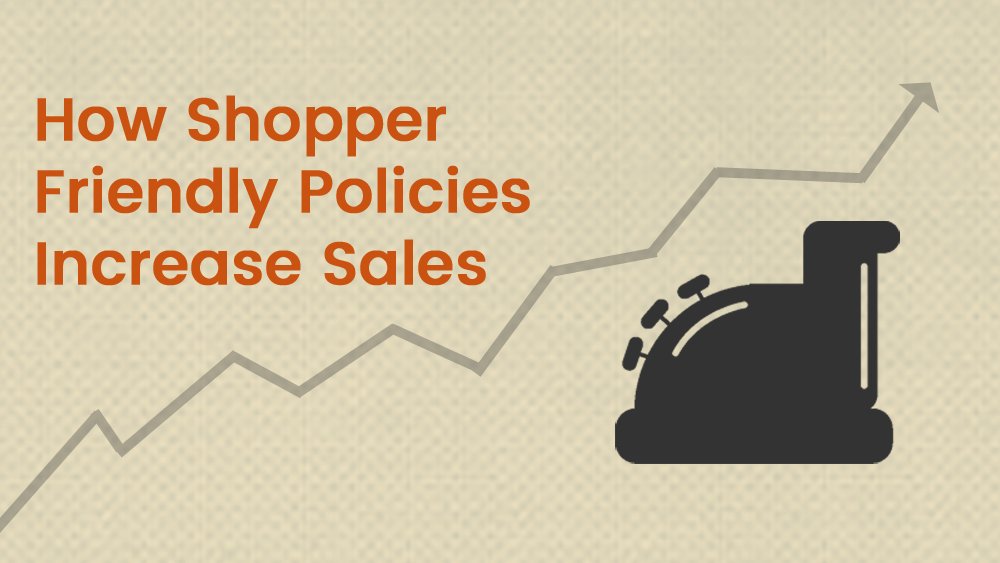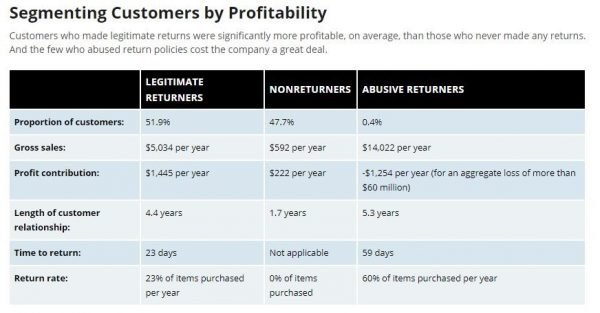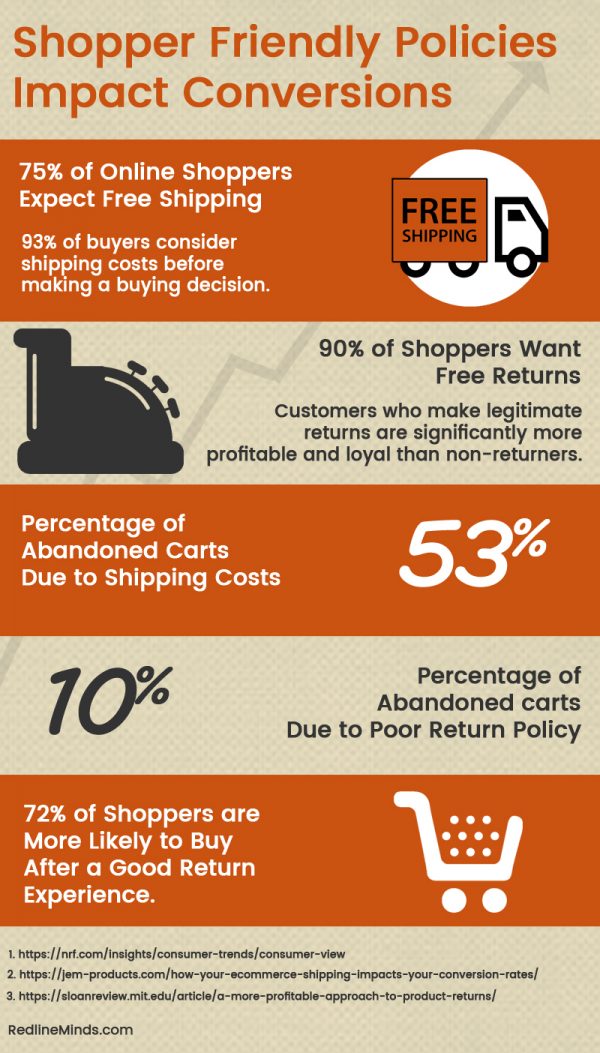We’re all in business to make a profit. Since profit equals sales minus costs, store owners generally try to reduce costs in an effort to increase profitability. Shipping and returns are expensive so it is pretty common for stores to look for ways to lower these costs. Some owners try to avoid all costs and never even test to see what works best for their store. However, it can be a mistake to create overly strict policies in an attempt to lower operating costs. Your public shipping and return policies have a major impact on whether or not a shopper makes a purchase. A hasty decision here can cost more than it saves.
If your attempts to manage costs have a negative impact on your customer experience, you’ll sell less. When I shop or do site analysis I see so many stores with unfriendly or poorly written policies. It isn’t always new stores either. I recently stopped buying an entire brand because of a negative experience. As a shopper, service policies absolutely influence whether or not I buy from a site.
So as you formulate or review your policies, it is key to know that they are just too important for your business to not do some research and testing to figure out what is best for your business.
We function in an Amazon world
My good friend, conversion optimization expert, and author of Be Like Amazon, Bryan Eisenberg loves to remind store owners that they compete in an Amazon world. Last year Amazon sold nearly half of all products sold online during the holiday season. Given that there are millions of online stores, and that this number grows daily, that’s a scary number for the rest of us. Given the size of their catalog, reputation for low prices, and excellent customer service, you would be wise to remember that you compete directly with Amazon.
This is true even if they don’t sell your exact product as every dollar spent represents a choice made by a shopper. “Do I buy item A or B?” “Do I have steak for dinner or chicken?” If your store doesn’t earn that dollar, another store likely did. This doesn’t mean you should abandon your dream of e-commerce riches. If you pay careful attention, you’ll find that Amazon actually doesn’t carry everything in the world, and they aren’t always the cheapest. Yet their growth continues. As a store owner, you need to ensure your store has a strong value proposition and is customer-friendly to support growth.
Now think like a buyer. Why do you buy from Amazon or from any other store? I know why I continue to buy from Amazon. I buy for three reasons
- they usually have what I want and an excellent selection of options; and
- I know that I will get fast, free shipping; and
- that if I don’t care for it, I can easily return it. No hassle.
Free shipping and easy returns. I buy from other stores too and these three reasons dominate those decisions too. So you have great products. That’s reason one. How are your policies regarding reasons two and three? How do you make buying decisions? More importantly, how do your customers make their choices? Think like your shoppers.
Friendly shipping and return policies increase sales
I have written previously on how a friendly return policy can increase your sales. However, your shipping policies, and, more specifically, what you charge for shipping is absolutely a key factor in whether or not a shopper buys from you. Plenty of industry research supports this premise. Let’s look at the statistics.
93% of buyers consider shipping costs before making a purchase. Most people expect free shipping. The National Retail Federation (NRF) reports that
“75% of online shoppers expect free shipping!”
The expectation of free shipping was true even on orders under $50, up from 68 percent a year ago. Ouch!
They also expect to receive their package quickly so the decision to “slow boat” using the cheapest possible shipping methods may also cost you sales. Slow shipping can also result in bad reviews which further hurts your business. Faster delivery is also a key advantage over the rising tide of very low cost, dropship from China websites. Competing by focusing on having the lowest price is a race to the bottom. Even Amazon is quietly not always cheapest. The truth is that most shoppers will pay more to get items faster from stores that are easy to deal with.
While a larger merchant may be able to absorb these costs, for a small merchant that is a painful statistic! The desire for free shipping is so strong that buyers will accept a higher price to get free shipping. Shipping and other unexpected costs are the number one reason people abandon their shopping cart during checkout.
If you could reclaim 53% of your abandoned carts what would that do to your revenue?
More statistics on customer behavior as a result of shipping costs
- 4% said they made a purchase in the past year specifically because of a free shipping offer.
- 50% said they avoid retailers that don’t offer free shipping.
- 84% of consumers said they’ve added items to their cart over the past 12 months in order to meet a free shipping threshold. That figure jumps to 90% for millennials, one-third of whom said they do it all the time, and 85% for Gen Z shoppers.
Pay attention to these numbers! While shoppers may expect free shipping for an order of any size, nearly all will add more to the cart to hit a free shipping threshold. So set your threshold for free shipping to be competitive and increase your average order size.
Your returns policy has an impact on cart abandonment too
10% of shoppers say they abandon their cart due to a poor return policy. Dotcom’s study revealed that 90% of shoppers want a free return policy. Another study suggests that up to 85% of shoppers look for and read your return policy before making a purchase, so the percentage of shoppers you lose is actually much higher as most will read your policy before they even get to checkout. If they don’t like your return policy they leave.
It can be a mistake to assume all returns are a bad thing. It depends on the nature of your business. Research has shown that 77% of returns come from repeat buyers and that 72% of shoppers are more likely to buy when they have had a good return experience. Instead of focusing on a single event, it pays to look at the bigger picture and measure returns against your overall business goals and growth.
Your policies still need to fit your business and your specific market. Check your competition. Can you improve on their offer without hurting the bottom line? You may need to test options to see where you can beat your competition without losing customers and without losing money. Keep in mind that there are some products where accepting returns is impractical or illegal. There are many choices to make as a business owner and most do quite a bit of testing before settling on a policy. In most cases, liberal policies increase sales.
Keep in mind that the goal is exceptional customer service and your return policy needs to fit your business. Accepting product back and issuing a full refund isn’t your only option. Stores have the option to issue a full or partial refund without accepting expensive-to-ship products back or issuing store credit. There are also some products that may be illegal to take back.
How to not lose money with customer-friendly shipping and return policies
To begin with, you must measure and track results. The end game math is:
[Total revenue (including collected shipping fees) – refunds] – [Cost of goods sold + shipping costs + non-saleable items] = gross profit
Profits drive growth
The goal of higher sales is secondary to the goal of larger profits. As you test you are looking for the “sweet spot,” where your generosity gives you more profit than it costs you. Your profit margin may drop but if the net result is higher net profit, your business is growing and you’re making more money.
You must track everything
What are your shipping costs? Which methods result in better profits? Which products come back too often and why are they returned? Who returns a product and how often. You will want to block people who make illegitimate returns or who abuse your policies. Look at your Lifetime Customer Value (LCV) and compare the rate of return to the overall profitability of that customer. You may be surprised to find that your returners are often your most profitable customers.
Managing shipping costs
Shipping is another place where managing costs can greatly impact your profitability. Here are a few tips for saving money on shipping costs.
- Choose a generic name for your free shipping method. This gives you the freedom to ship via the cheapest method. For example, if you offer “free shipping, you can ship via USPS Priority, UPS or FedEx Ground or wherever you have found the best rate.
- Don’t limit your business to a single carrier. The carrier that provides the cheapest price to you will vary based on product weight, size and the distance between you and the recipient. Don’t just settle for a single shipping service based on convenience for you. Do consider packaging prices as sometimes USPS is cheaper after box cost due to the availability of free Priority Mail boxes.
- Offer shipping upgrades. Surprisingly, offering even “standard shipping” or ground at a price will result in some shoppers choosing that method because the assumption is that this is faster than free shipping. I do recommend trying to get orders with paid shipping out the door faster if you can. You can either charge full price for upgrades or discount them by the cash value, or part of the cash value, of your free method. You will likely see more upgrades if this is subsidized to some degree.
- Consider making upgrades generic too. Amazon doesn’t say “UPS 2 Day” and they never have. They just say “2 Day.” That’s because they rarely have to use an air carrier to hit delivery promises. If you list “FedEx Overnight” and the buyer is 1 day by truck, and you opt to ship by ground, the customer will feel that you cheated them. by avoiding the label, you can prevent this poor user experience. Just be aware that once in a while a ground method will miss a promised delivery date. When this happens, be prepared to issue a refund for the upgraded shipping cost.
- Use shipping software that offers discounted shipping rates. ShipStation, ShippingEasy, and EasyShip offer access to lower, commercial rates. Another major advantage is that software will allow you to compare options for the lowest price. This supports the use of generic shipping methods. Remember that the time you save processing shipments and returns is also a cost-saving to your business.
- Use Refund Retriever or an app like it. Refund Retriever monitors your shipments and automatically submits late shipments for refunds. This way you get the difference back if you’ve paid for overnight shipping and it arrives late without the time hassle of doing this yourself.
In summary, it is worthwhile to do some research and testing in order to determine what your customers expect when it comes to your service policies. A failure to be competitive can cost you sales. Friendly policies, especially when they outdo your competitors, can give you an advantage that tips the scale towards making your store a preferred source. What seems like a cost may actually increase profitability and speed growth.
How friendly are your policies? Have you done any testing to find the “sweet spot?”
Additional resources:
https://sloanreview.mit.edu/article/a-more-profitable-approach-to-product-returns/
https://www.shopify.com/enterprise/ecommerce-returns
https://multichannelmerchant.com/operations/shoppers-say-poor-shipping-options-derail-ecommerce-orders/








